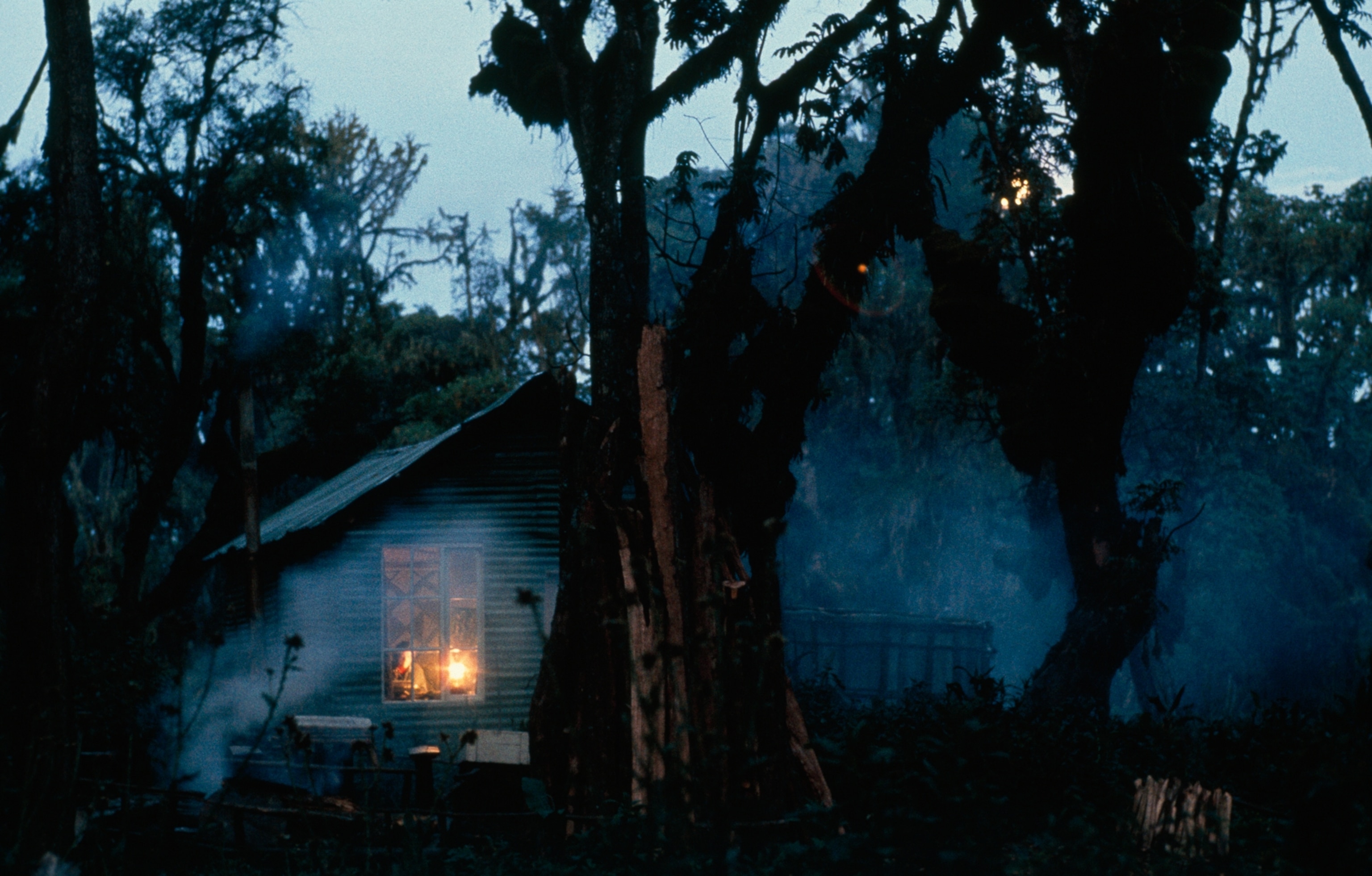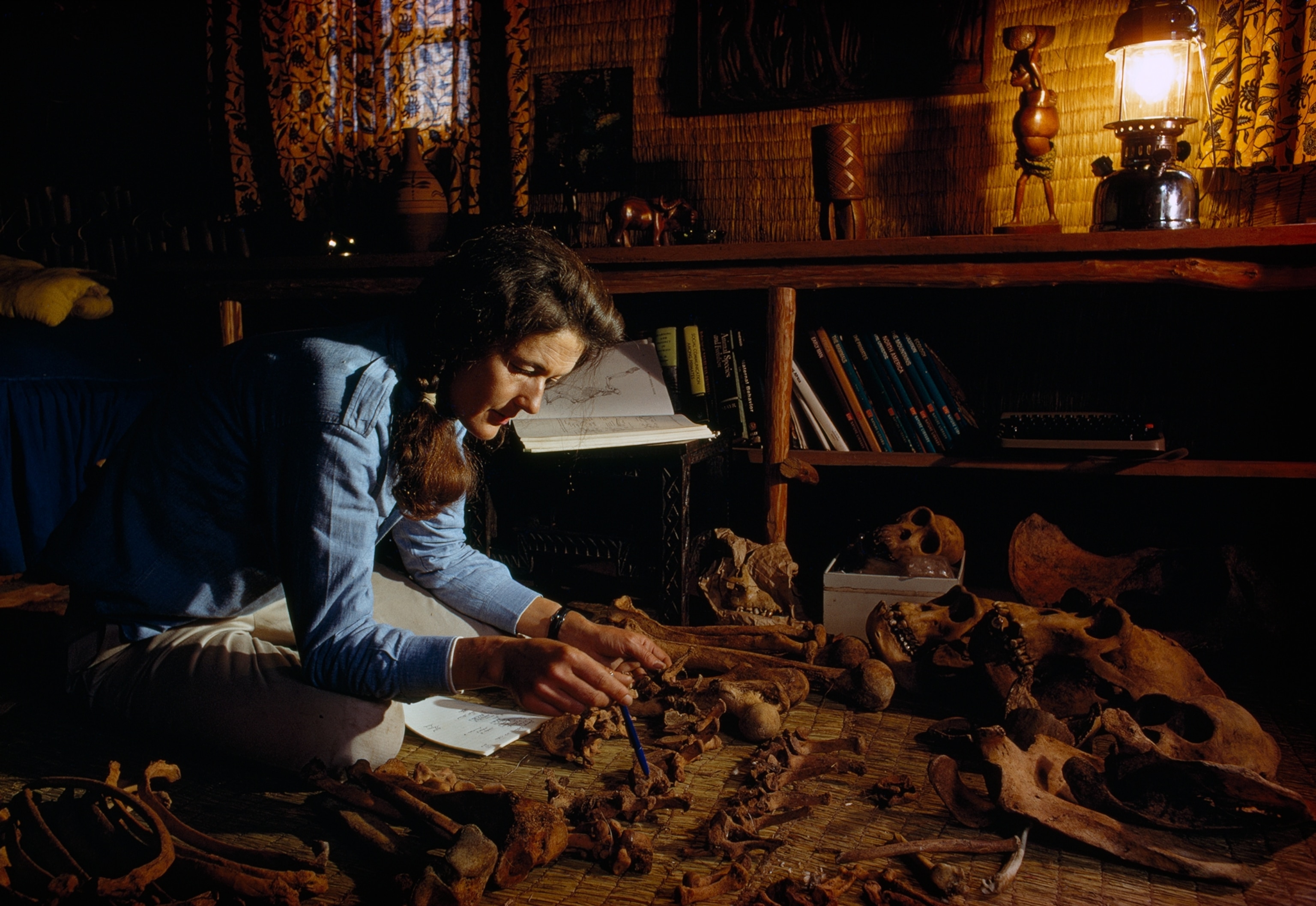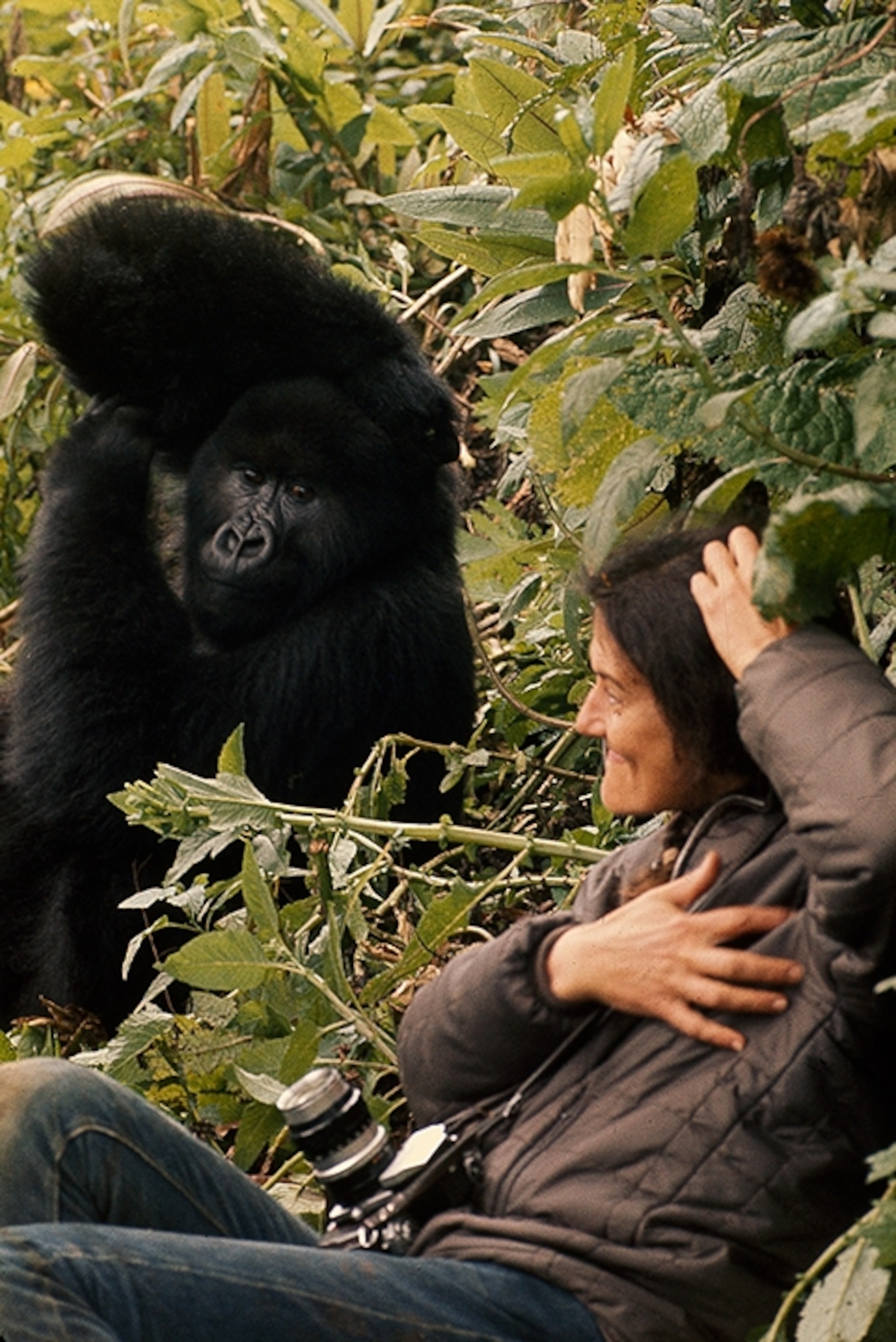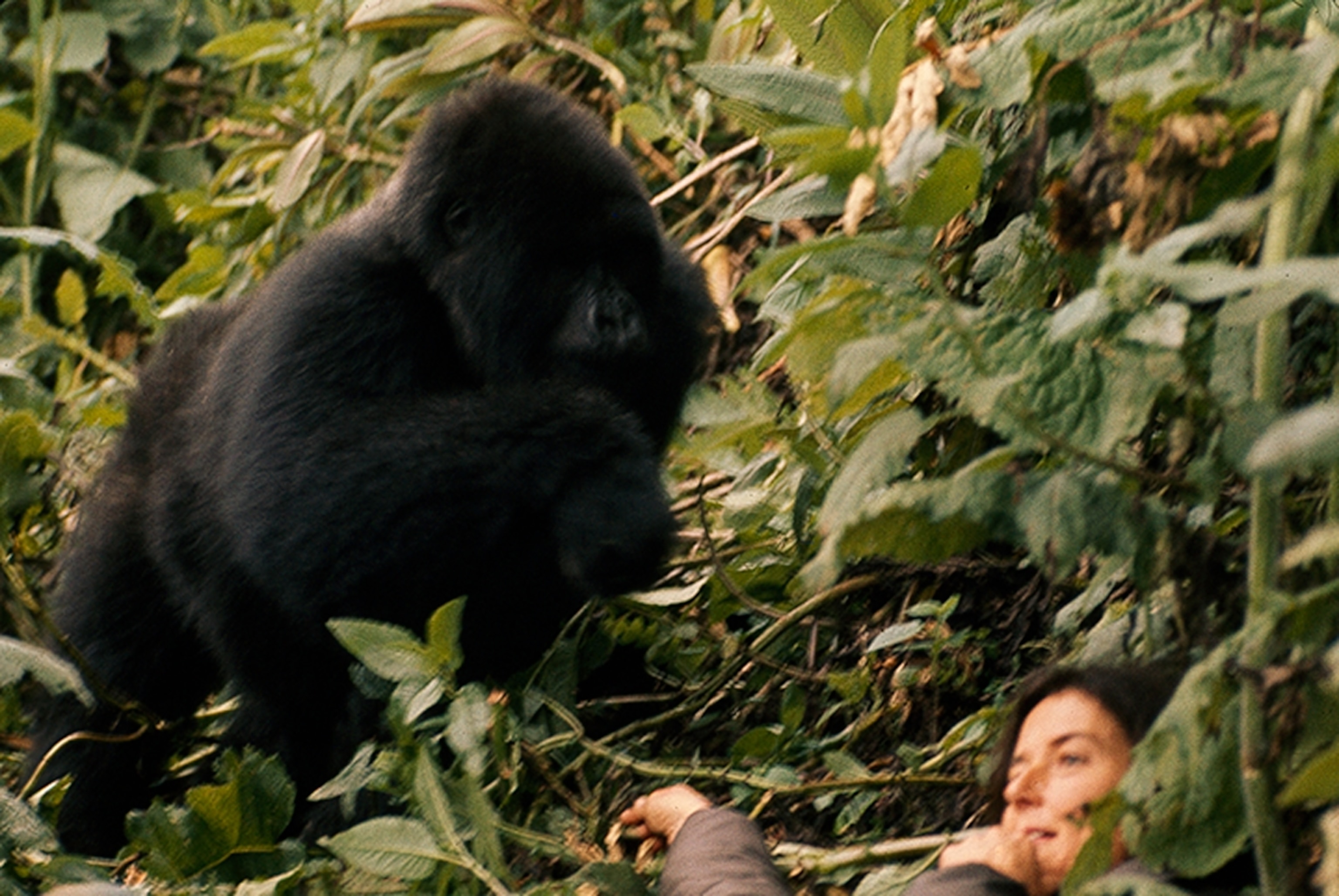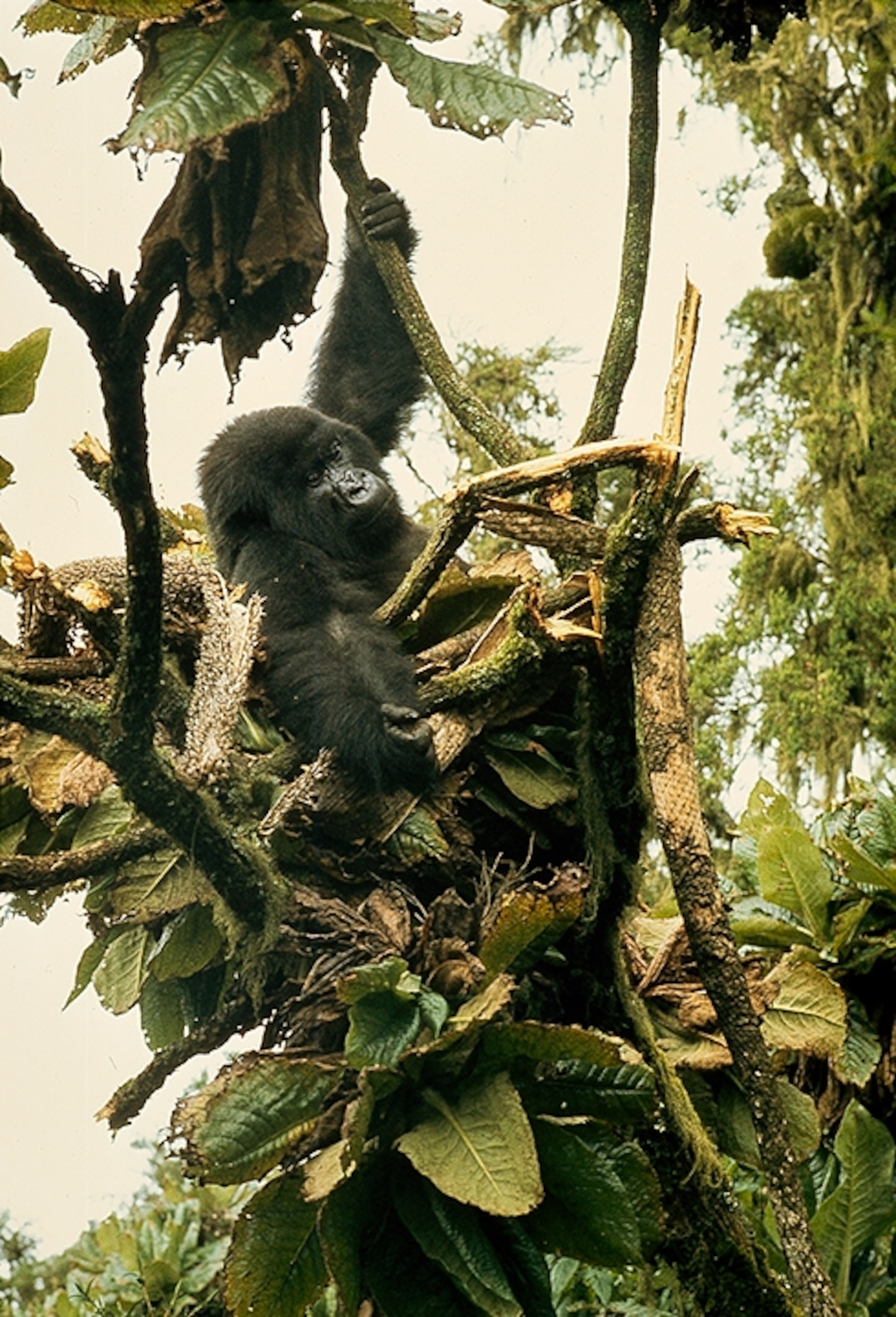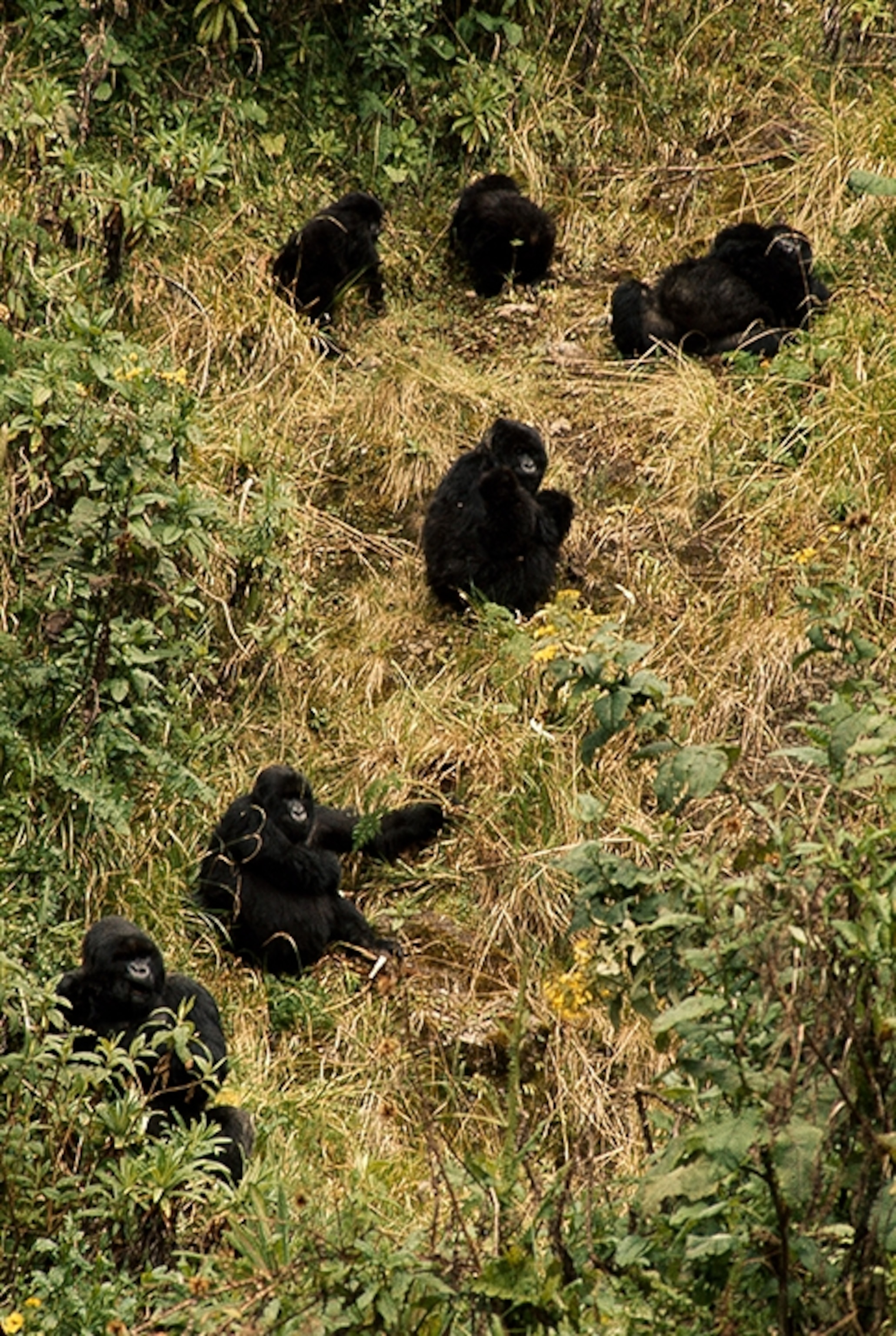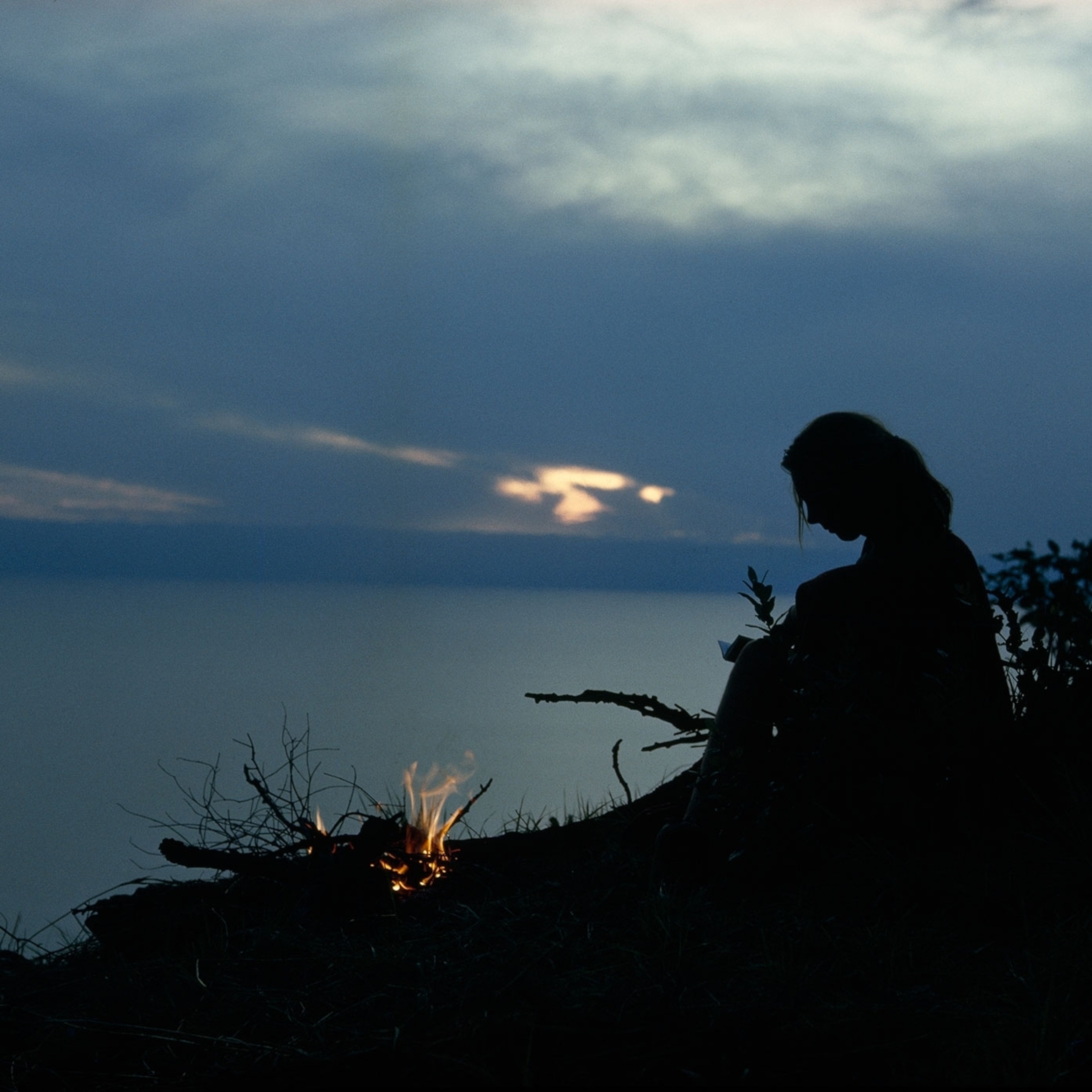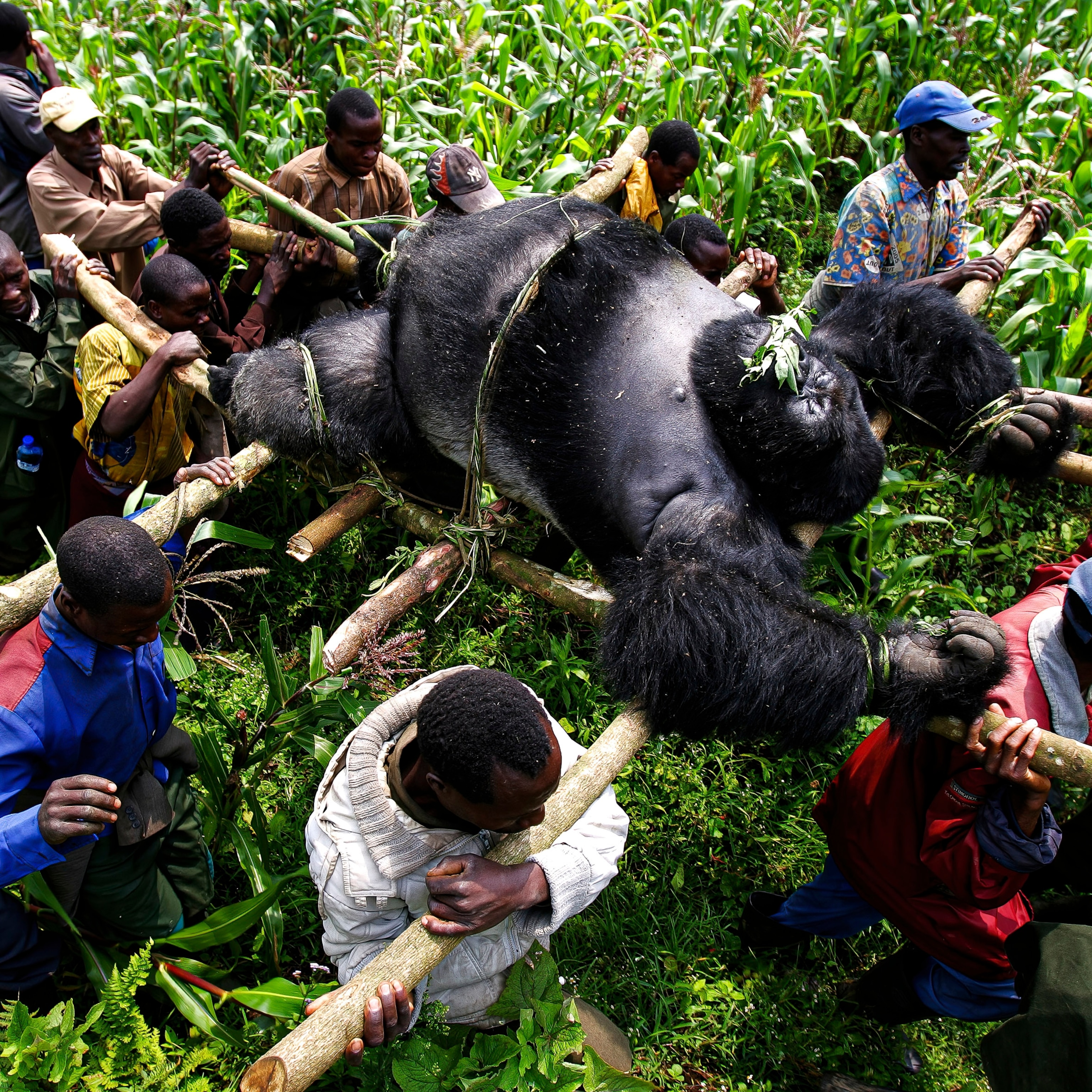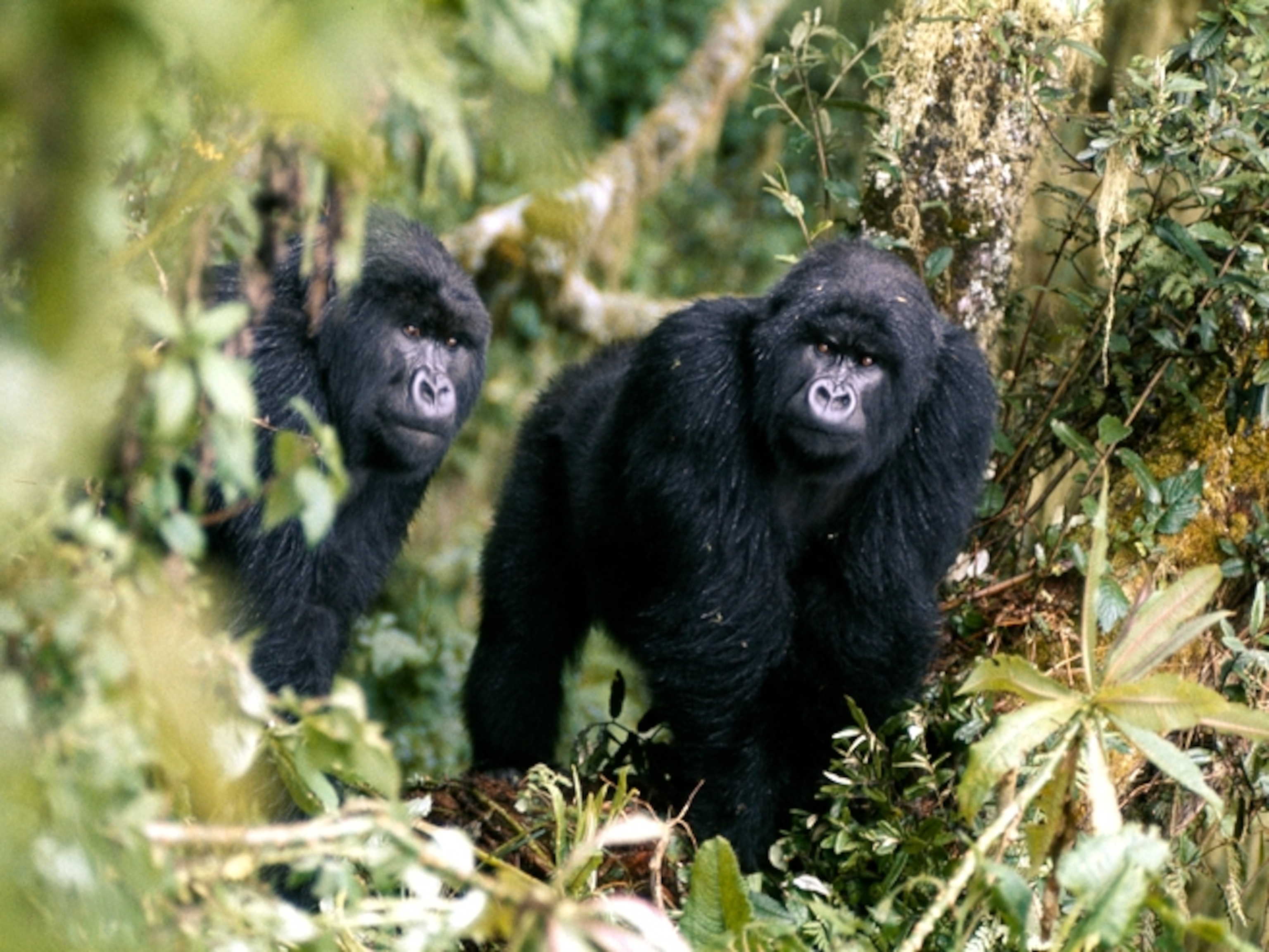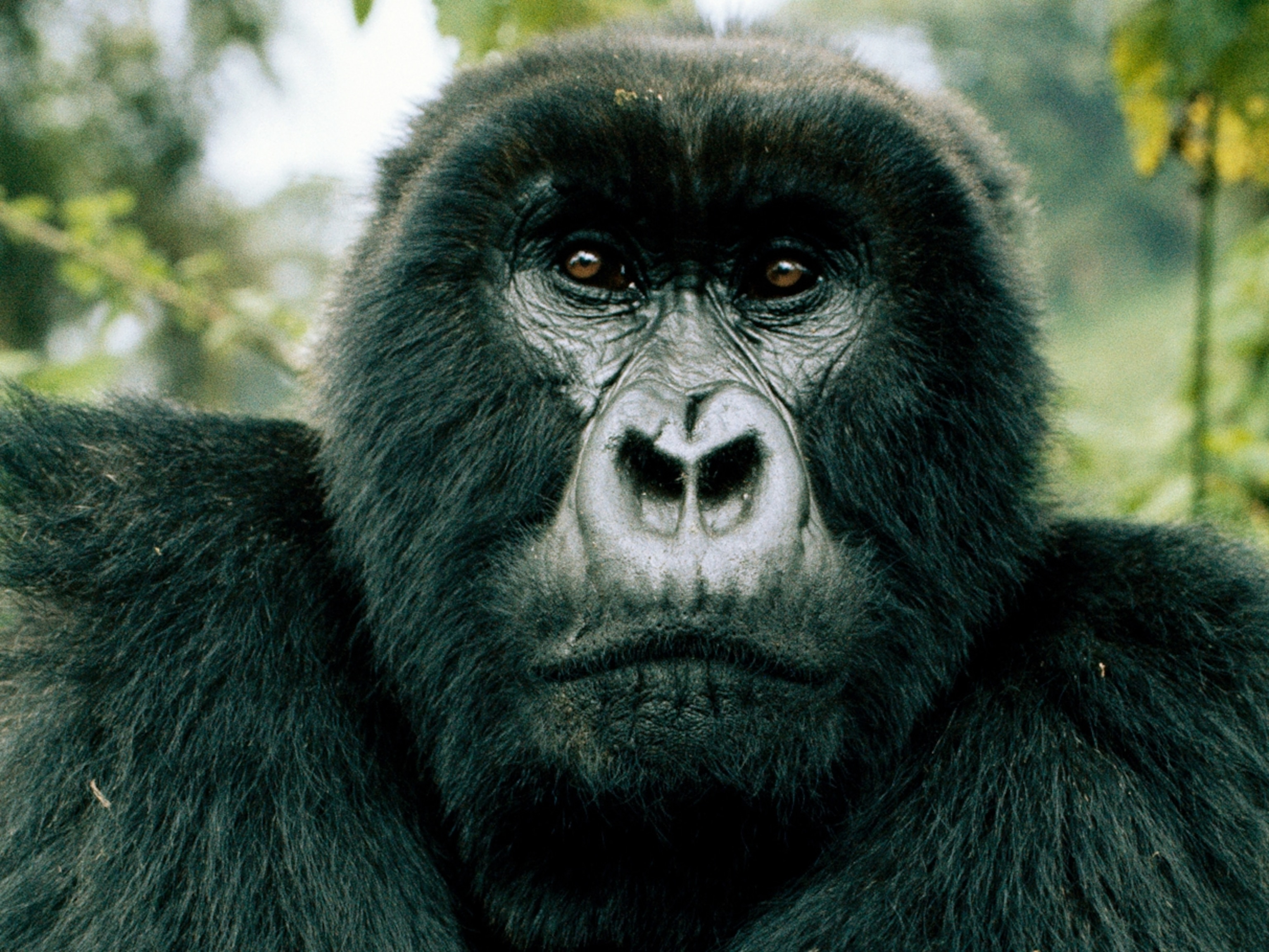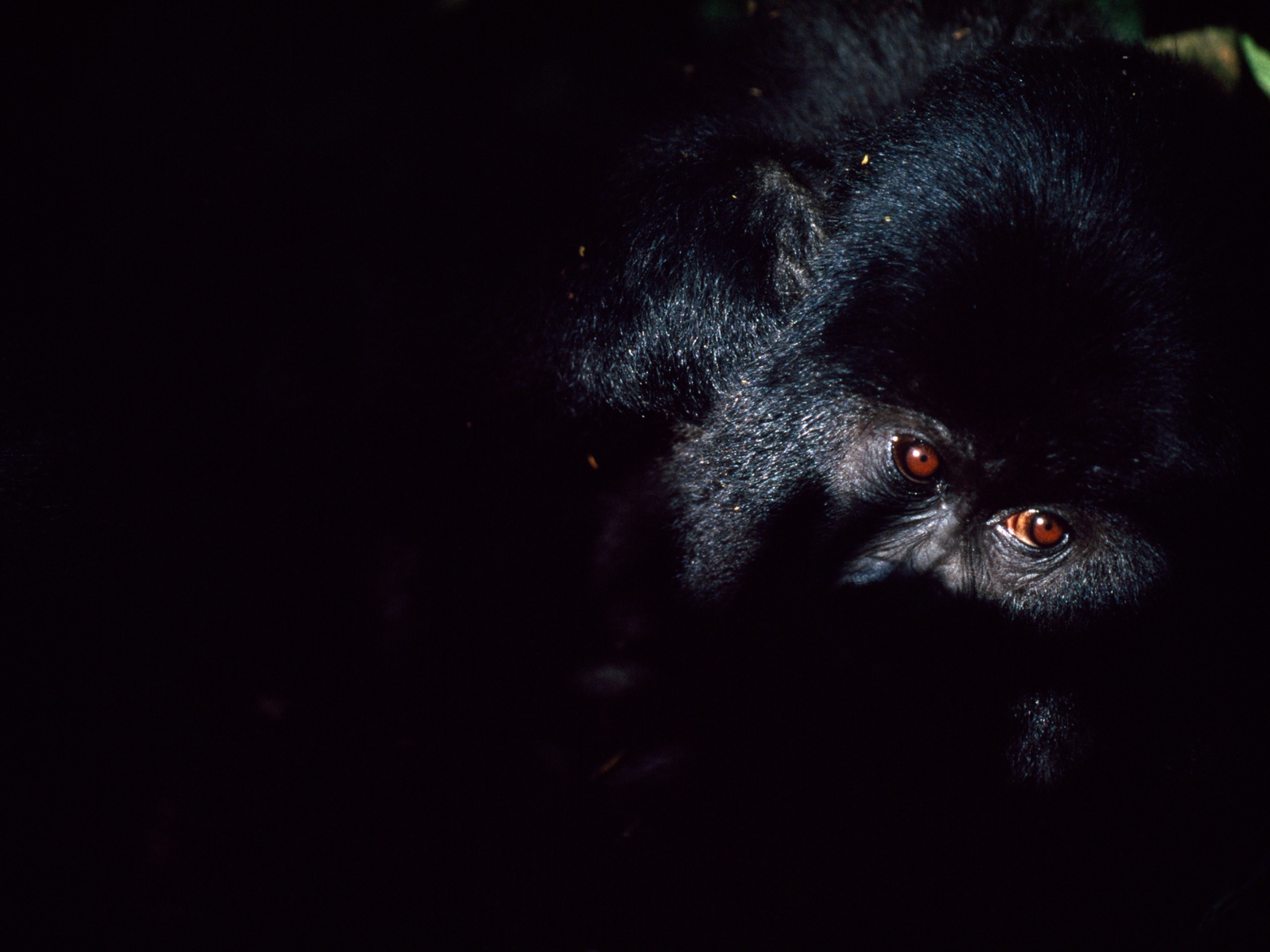Two black hairy arms circled the tree trunk. A moment later a furry head appeared. Bright eyes peered at me through a lattice of ferns.
I occupied a branch of another tree, slightly downhill from the gorilla who stared at me. We were both in a forest on Mount Visoke in Rwanda, where I have been studying gorillas in the wild.
The face was familiar, not only by its features but by its impish expression; it belonged to Peanuts, one of my favorite gorillas. He is a member of one of the groups I have studied closely, and that have grown used to my presence among them.
Peanuts was wearing an expression I think of as "fun and games"; I have learned to recognize it in gorillas when they want to prolong a contact with me. Slowly, I left the tree and got down into the foliage to make feeding noises to reassure him.
The moments that followed are among the most memorable of my life. They were particularly important to me because this was, in a sense, a farewell visit to the mountain slope. I was shortly to leave Africa for a prolonged stay in Cambridge, England, where I would begin working on a doctoral thesis and other technical reports on gorilla behavior.
Peanuts left his tree for a bit of strutting before he began his approach in my direction. He is a showman. He beat his chest; he threw leaves into the air; he swaggered and slapped the foliage around him, and then suddenly he was at my side. His expression indicated that he had entertained me—now it was my turn. He sat down to watch my "feeding" but didn't seem particularly impressed, so I changed activities; I scratched my scalp noisily to make a sound familiar to gorillas, who do a great deal of scratching.
Almost immediately Peanuts began to scratch. It was not clear who was aping whom. Then I lay back in the foliage to appear as harmless as possible, and slowly extended my hand. I held it palm up at first, as the palms of an ape and a human are more similar than the backs of the hand. When I felt that he recognized this "object," I slowly turned my hand over and let it rest on the foliage.
Peanuts seemed to ponder accepting my hand, a familiar yet strange object extended to him. Finally he came a step closer and, extending his own hand, gently touched his fingers to mine. To the best of my knowledge this is the first time a wild gorilla has ever come so close to "holding hands" with a human being.
Peanuts sat down and looked at my hand for a moment longer. He stood and gave vent to his excitement by a whirling chest beat, then went off to rejoin his group, nonchalantly feeding some eighty feet uphill. I expressed my own happy excitement by crying. This was the most wonderful going-away present I could have had.
Human Pressures Shrink Gorilla's Domain
My farewell handshake with Peanuts came after more than three years of study of the mountain gorilla (Gorilla gorilla beringei), largest of the great apes. The animal is already classified by international conservation authorities as "rare." Under constant pressure from man—hunter and farmer—it is being driven into ever-smaller, more-remote mountain areas. Extinction is a real threat.
My studies are conducted from a camp in Rwanda's Parc des Volcans, on the saddle between Mount Visoke and Mount Karisimbi, two of the eight volcanoes in the Virunga range. Camp, which consists of several sheet-metal cabins, stands at 10,000 feet; a rough jeep road starts up the mountain, but the last 2,000 feet must be climbed on foot, a winding, three-mile hike. In addition to the gorillas, local fauna includes duikers and buffalo, and elephants frequently visit a creek in front of my cabin. The nearest store is 19 miles away.
My work began in 1967 with help from Dr. Louis S. B. Leakey and aid from the Wilkie Brothers Foundation. Shortly thereafter the project gained, the support of the National Geographic Society which has continued to sponsor my research. A report appeared in theGeographic of January 1970. Much has happened since, but my job is far from finished.
There had been scientific observations of wild mountain gorillas in the past, notably a research project by Dr. George B. Schaller in 1959-60, a classic in its field. My objective was to take up where these had left off, to form more intimate contacts with gorilla groups and individuals, to observe from close up their behavior, their interactions—and to do this in such a way that my own presence did not affect that behavior. To accomplish this I decided, in a word, to act like a gorilla.
One of the first things I learned about my subjects was that despite their great bulk—400 pounds or more—and the many tales of ferocious attacks on people, they are in fact among the gentlest of animals, and the shiest. Like most wild creatures, they will try to protect themselves when attacked and to guard their young. But in some 3,000 hours of contact I encountered only a few minutes of aggressive behavior. These incidents were generally initiated by protective adults when their young approached me too closely. In all instances the "charges" proved to be bluff.
A good example of their gentleness and sense of mischief occurred one day when Bravado, a young male, tried to climb past me down a tree trunk where I had settled myself on a limb to observe and take some pictures. Bravado made his way up easily enough, brushing past me as if I were not there. But on the way down he apparently decided I was in the way and should move. Once his head filled my viewfinder, I decided it was time to turn my back to him. Just as I got a good hold on the tree, I felt two hands on my shoulders, pushing down.
I had often seen gorillas do this to one another when they wanted the right-of-way on a narrow trunk. Not wanting to risk a fall, I refused to budge. After another moment of gentle pressure—only a fraction of the mighty shove he could have given me—Bravado moved back. He beat his chest, then jumped out onto a side limb. He hung there by two arms, bouncing deliberately, knowing that his weight would break the branch and thus provide a satisfactorily loud snapping noise. He succeeded; the branch broke with a crash and Bravado landed eight feet below, where he calmly began feeding.
Learning to Sound Like a Gorilla
In my years of study I have watched nine groups of gorillas, but for closeup contacts have concentrated on four. The groups vary in size from 5 to 19 members; the average is 13. In my field notes I identify groups by numbers, and individuals by names I have chosen, usually trying to match names to the personalities of the animals.
Each group is ruled with unquestioned authority by a dominant male—a silverback, so-called because with age a gorilla's dorsal hair turns silvery gray. Below him may be one or more subordinate silverbacks, then the younger mature males—blackbacks—the females, juveniles, and infants.
During my observations, I have learned much about the animals' feeding habits, their range and movements, their bickering and play. I have watched them build day nests to rest in and night nests to sleep in—crude beds of boughs, leaves, moss, or even loose dirt—sometimes in trees but generally on the ground.
Early in my study I decided that one of the best ways to persuade gorillas to accept my presence was to imitate the sounds they make. In this I had a stroke of luck—though the event itself was most unfortunate. Two young gorillas, captured for a European zoo, had been so mishandled that they were near death, and I volunteered to nurse them back to health. While I cared for them I learned much about gorilla vocalizations.
Popular literature generally describes roars, screams, and"wraaghs" as the main components of gorilla vocabulary. I was to learn there is a lot more to the subject than that.
From my two charges, for instance, I learned an infant's version of a sound that I later came to call the "belch vocalization." Their rendition, "naoom, naoom, naoom," was usually associated with eating, and I have since heard this sound many times among wild groups. It does not carry far, and has often been mistaken for a stomach rumble. But in fact it is a distinctive type of gorilla communication, exchanged in situations of maximum contentment.
Typically, one animal expresses his feeling of well-being by giving a belch vocalization. This brings a chain of similar responses from nearby animals. On occasion I have been able to crawl undetected into the midst of a contentedly feeding group and begin a belch vocalization series of my own and have it answered by animals around me.
The belch vocalization is the most common form of intragroup communication. Others include what I call "pig grunts" and "hoot barks." The pig grunt is a harsh staccato sound used in disciplinary situations, as when a silverback settles a squabble or orders his group to move on. Females also use it, in a softer tone, to control their infants.
The hoot bark is more often heard when an animal is curious or alarmed. When given by the dominant silverback, it usually attracts the immediate attention of the group.
Gorilla vocalization has been a particular interest of mine. I have spent many hours recording these sounds, and the tapes have now been taken to Cambridge University for further study. But my prime interest is still the original one: To use the sounds to gain acceptance by the gorillas, and so to study behavior and ranges.
Research Can Help Save Big Apes
Why do gorillas go where they do? Do their routes remain stable or do they vary? How many still survive? What is their present territory? I have compelling reason for wanting to know. If we are to save the animals from extinction, we must find answers to these vital questions. We must learn the areas of known population concentration before we can provide protection—and thus my interest in both an accurate census of gorilla numbers and a study of gorilla ranges.
Over many months I have had a rare, perhaps unique, opportunity to watch, close up, three of my gorilla groups in a state of flux. The studies involve:
Group 4, headed by a silverback named Uncle Bert, who was nervous at first in his leadership role.
Group 8, five bachelors led by Rafiki and including my friend Peanuts.
Group 9, led by Geronimo.
Over the past 3 1/2 years I have charted the movements of these groups. The resulting range maps are amoebic in outline. But as I revise them to keep them up-to-date, I see that my amoebas are moving, and two of them are showing signs of merging. The changes began almost imperceptibly, but have recently speeded up.
Tragedies May Have Altered Ranges
I cannot yet be sure of the reasons for these changes, but two apparent causes must be considered. Both were small tragedies, mentioned in my earlier article.
One was the death of Koko, the elderly, sole female of Group 8. The remaining five males have increasingly sought proximity with the other two groups that shared the borders of their range—Group 4 to the south and Group 9 to the north. Obviously bachelorhood isn't all it is cut out to be, for the males of Group 8 are no longer content with their own company.
Unfortunately, the members of Group 4 were having their own troubles. Their dominant silverback, Whinny, died, leaving his followers under the nervous authority of the second dominant silverback, Uncle Bert.
In his new responsibilities Uncle Bert was—especially at the outset—overly strict and domineering. One of his early moves was to eject a subordinate silverback named Amok.
Poor Amok. For a time it appeared he might join the five bachelors of Group 8, but he has now become a loner. He leads a solitary and silent life, roaming in what seems to be a haphazard fashion. When occasionally I see him in the woods, his only vocalization is a"wraagh" of alarm as he flees.
As an overprotective leader, Uncle Bert fled from the advances of the burly bachelors of Group 8. This he did by leading his own group away to the relatively empty southern slopes of Mount Visoke.
The result was that the "terrible five" concentrated solely on following Geronimo's group. In 1969 and 1970, the two patterns that represent the ranges of Groups 8 and 9 merged into almost the same blob—a trend that appears to be repeating itself in 1971.
This is not to imply that Geronimo has welcomed the advances of Rafiki's bachelors. With the proximity, aggression has increased among the silverbacks, not just with members of rival groups but within their own band. Chest beating, branch breaking, ground thumping, and bluff charging are all used as substitutes for direct clashes.
Sometimes, after prolonged hounding by Group 8, Geronimo would keep his group on the move for hours, covering miles with little or no time out for feeding or day naps. In such forced marches they often succeeded in losing Group 8—but only for a few days at a time. Should this trend continue, both groups may eventually move north out of my study area to the opposite side of the mountain. I hope not, for then I may never learn the outcome of this drama—whether Groups 8 and 9 will really merge, or whether the bachelors will somehow take away one or more of Group 9's seven females.
Swinging Feast Takes Toll of Branches
Slowly, as Groups 9 and 8 head north, Group 4 is returning to the western slopes where they previously ranged and now have almost free run of the mountain.
The subject of ranges and the reasons they change is proving to be complex. Group interaction is the most likely cause (outside of human intervention). Certainly the quest for food is not a major factor. Seasonal food favorites cause slight fluctuations in range, but most items of the gorilla's staple diet—leaves, vines, wild celery, and other succulents—abound in the mountains.
The fruit of Pygeum africanum is a delicacy on any gorilla's menu. The tree resembles a large oak, favors ridges, and bears a fruit like an oversize cherry. Because of the relative scarcity of the tree and its brief fruiting season—only two to three months a year the ridges that support it attract gorilla concentrations, and the many broken branches after a raid bear witness to the acrobatics of the great apes. It is an awesome sight to see them, especially the bulky silverbacks, maneuvering in treetops better suited to chimps or monkeys.
One day during the height of the fruiting season, I returned to a grove of Pygeum trees that had been shared by Groups 8 and 9 for more than a week. Photographer Bob Campbell (who eventually became as familiar to the gorillas as I did) was with me. But when we reached the trees, we found them empty.
"I'm not surprised," said Bob as he looked at the totally trampled area. "There's barely enough foliage left for even a single day nest." We agreed that the two groups must have gone higher up on the slopes. As we continued to climb through the clutter of broken tree limbs, I spotted a branch still bearing several ripe fruits. On a whim I picked three of them and put them into my pocket.
Some twenty minutes later we met Group 9, contentedly sunbathing and feeding. Geronimo gave a few mildly curious hoot barks that brought several animals forward to stare momentarily. Then all was silent as they resumed their day rest period.
We found Group 8 about 200 yards away, sunning and napping. We settled down quietly to watch their interactions.
About two hours later we heard Group 9 feeding through the thick undergrowth, moving slowly in the direction of Group 8. But then, to our disappointment, Geronimo led his group off downhill in the direction of the Pygeum trees, and Rafiki's bachelors followed at a discreet distance.
When they were all out of sight, Bob and I reluctantly began to pack up our gear for the long trek back to camp. The day seemed a total failure.
Impish Trick Prompts Exciting Contact
Suddenly Peanuts popped up just behind me from the side of a log. He seemed quite pleased with himself! His impish expression seemed to say, "Well, I put one over on you, didn't I?" Indeed he had, and I longed for some way to reward him for his visit.
Then I remembered the three Pygeum fruits in my pocket. Slowly I put one on top of the log—expecting him to back off. Much to my surprise he popped it into his mouth. He then looked me straight in the face as if to ask for more. I extended the other two fruits on my flattened palm. His rough-skinned fingers grasped them without hesitation.
At that moment I would have traded the boots on my feet for more Pygeum fruits. After waiting politely for several seconds, Peanuts strutted to my other side and leaned toward me as if to say, "What a miserly provider you turned out to be!" Then off he whirled in pursuit of his group.
On other days Bob and I enjoyed wonderful contacts with Groups 8 and 9. On one occasion Geronimo, in his role as guardian of Group 9, had stationed himself on a log directly below us where he could keep a watchful eye on all of us. He issued small alarm barks when the show-off, branch-breaking displays of the bachelors of Group 8, who were directly above us, became too loud. An infant of about a year and a half followed him onto the log to strut and swagger in a very important manner—but at the same time took care not to get too far from the huge form of security that Geronimo represented.
Slowly the other members of Group 9 began to feed down in his direction, most of them pausing in turn to sit on the open trail in front of me, stare, and feed. I welcomed the chance to observe the growth of the infants, some of whom I had first seen when they were only little pink-skinned dependent squiggles. Now they were fluffy miniatures of adults, strutting on the trail before me. While I was taking notes as fast as I could, I heard an excited whisper from Bob.
"Look at the new infant!"
At that moment I was watching a tiny creature of some 3 months clinging to its mother's chest hair while she ate Galium vines. Then the foliage parted and an elderly female plopped down before me. Slung over her right arm was a brand-new infant, limp as a pink rag doll. Its head hung backward over her arm, eyes closed, mouth opened slackly, and all four limbs were drooping. It appeared lifeless. When she shifted its weight, the little one made no response.
As the group moved off across the gully, I watched this female through my binoculars until she reached the mother with the older infant, and sat down beside her. Much to my relief, I could see that both babies were wiggling with typical spiderlike movements.
Tree Climbers Let Infants Dangle
Then to my dismay I saw that both mothers were eyeing two fruit-laden Pygeum trees that towered 80 feet. "They wouldn't dare," I whispered to Bob indignantly.
I was wrong. They stood, placed their infants higher on their chests and began to climb, using all four extremities, letting the babies hang on as best they could.
Fifty feet up, the two infants had slid down below the mothers' abdomens, and I feared for their safety. No need—just in time, the females stopped, repositioned the babies, and climbed on up to the fruit. The descent was equally breathtaking; again, the infants slipped lower and lower, until they were almost around their mothers' ankles by the time they reached the ground.
In Group 4 I have observed "aunt behavior," with a designated baby-sitter. A female named Flossie has received this dubious honor; she sits contentedly with the youngsters playing over and around her while the mothers are some distance away feeding or sunning. One young female frequently stays with her. This one will sometimes "kidnap" older infants to carry them in a somewhat awkward fashion some yards away from the aunt. There she builds a nest in which she tries to settle down with the infant. One thinks of human children playing house.
Slaughter Portends Survival Perils
As I write this article, I am back in my camp on Mount Visoke, my term at Cambridge ended. My long-planned census of gorilla population is beginning, with the help of four courageous young recruits and some cooperative Rwandan assistants. It will be an arduous, even grueling job.
The physical challenges will include covering each of six of the Virunga Mountains from saddle to summit, exploring every gully, ravine, and slope. The work will require an accurate count of the members of each gorilla group, as well as estimates of range.
One reason for the census is to underscore the need for protection of these rare creatures. As if to underscore it further, when I returned to camp I was greeted with news of a wholesale gorilla slaughter just south of my study area. The bodies of five animals were found scattered about in an arc of some 75 yards. They had been mauled by dogs, pierced by spears, and battered by stones, apparently just for the excitement of the hunt.
I think of the gorillas I have written about, whom I have come to regard as friends, and I wonder—will some of them be next?

